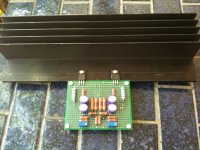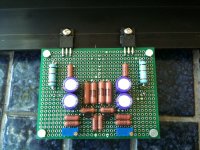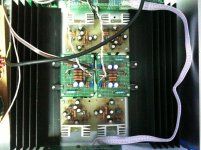Have you also tried IRF9610/610?....
Yes, long time ago - their inherent non-linearity makes them usable only as a CCS or as a voltage regulators, maybe cascoding devices.
IME, those are sub-optimal parts to use as amplifying devices in audio - maybe in guitar amps or in PA amps or in designs with a lot of NFB...
Last edited:
Have you also tried IRF9610/610?
I actually had the same idea as yourself a while ago, but it is often hard to find the time, especially when you have too many ideas.
Great work, these sought of reports are a great contribution. It will definitely motivate me to try it out
tried tested abused

they're simply not up to task , comparing to these ones
Yes, long time ago - their inherent non-linearity makes them usable only as a CCS or as a voltage regulators, maybe cascoding devices.
IME, those are sub-optimal parts to use as amplifying devices in audio - maybe in guitar amps or in PA amps or in designs with a lot of NFB...
luckily , I'm not an emg .... ing... img.... wtf! not even good at math


(now - you'll say that toobz aren't good for audio
 )
)Different bias voltage and you'd have to swap the 0.47 for 1 Ohm.
The F4 has less than unity gain, not very practicle for a headphone amp, imSo.
The F4 has less than unity gain, not very practicle for a headphone amp, imSo.
Last edited:
I thought low gain was preferable for HP amps, with a standard 2V in out its pretty loud. Besides I crank it up full all of the time so best to keep gain low😉
Would changeing the bias voltage be a simple adustment of the pot and maybe adjacent resitor that sets the Vref of the TL431?
Would changeing the bias voltage be a simple adustment of the pot and maybe adjacent resitor that sets the Vref of the TL431?
would the 2SK2013/2SJ313 be a drop in replacement for an F4 Head phone amp?
With some minor adjustments (as Jacco mentioned) it would be great. OTOH, when it comes to power-buffer for low Z headphones (but not lower than 25 Ohms) EUVL's DAO is my favourite ...
Yes, long time ago - their inherent non-linearity makes them usable only as a CCS or as a voltage regulators, maybe cascoding devices.
IME, those are sub-optimal parts to use as amplifying devices in audio - maybe in guitar amps or in PA amps or in designs with a lot of NFB...
Well IRF9610 is used in the front end of Aleph 3/30 etc, so they can't be too bad.
But I take your point, the toshiba devices are much more linear according to the data sheets.
Maybe I should also try the toshibas in the front end of my Aleph 30.
I also like the look of 2sj407, not sure if there is a complementary N channel version though.
Last edited:
Have you tried the exicon lateral mosfets?
If so how do they compare?
I prefer laterals in common-drain topology, like here.
I tried F5 with old Hitachi laterals (k135/j50) and it didn't sound bad, it was different from original F5 but not better...
...
Maybe I should also try the toshibas in the front end of my Aleph 30.....
I would not do that - you'd need a lot of current through that LTP and it doesn't seem like a good idea at all, especially in context of the amp as a whole.
Best upgrade would be to turn your Aleph into Aleph-J (Toshiba JFETs at the input.)
> The F4 has less than unity gain, not very practical for a headphone amp, imSo.
My DAO Follower also has unity gain.
All those who built it loved it, especially if you have low impedance phones.
Much easier to build than a down-versioned F4, may I add.
Patrick
My DAO Follower also has unity gain.
All those who built it loved it, especially if you have low impedance phones.
Much easier to build than a down-versioned F4, may I add.
Patrick
Best upgrade would be to turn your Aleph into Aleph-J (Toshiba JFETs at the input.)
Thanks. I have one of those too (ie Aleph J).
I have been away for a while, and I can see my enthusiasm is getting the better of me.
I will definitely be giving these mosfets a go in my F5.
How about using these on the burning amps 1 and 2 to replace irf610.
Do they really need to be biased high? How about 50mA or 100mA
I understand you want to bias them high on the F5 output stage, but do you really need to bias them that high in a circuit such as BA2.
The other option is to throw a power Jfet in that position, however that is an expensive option.
Do they really need to be biased high? How about 50mA or 100mA
I understand you want to bias them high on the F5 output stage, but do you really need to bias them that high in a circuit such as BA2.
The other option is to throw a power Jfet in that position, however that is an expensive option.
Looking good prakit 
You should be fine with that heatsink, just use white heat-transfer paste more liberaly 😉

You should be fine with that heatsink, just use white heat-transfer paste more liberaly 😉
To follow up my attempt to try this a line amp...
I supplied each channel with a set Jung's super regulator set at +/-23V as seem the attached picture. I've been listening to the line amp for a week now. This version of F5 with a pair of k2013/j313 indeed makes a very good lineamp.
I tried varying the bias of the output Mosfets up to 450mA where the regulators seemed running out of steam(the heatsink for the pass devices became very hot). It did sound better at higher bias but the dc drift at the output was getting bigger too. I settled at 250mA where it sounded good and the dc stability was good too.
This circuit should make a very good sounding headphone amp too.
Anything I can do to minimize the dc drift at higher bias?
Regards
I supplied each channel with a set Jung's super regulator set at +/-23V as seem the attached picture. I've been listening to the line amp for a week now. This version of F5 with a pair of k2013/j313 indeed makes a very good lineamp.
I tried varying the bias of the output Mosfets up to 450mA where the regulators seemed running out of steam(the heatsink for the pass devices became very hot). It did sound better at higher bias but the dc drift at the output was getting bigger too. I settled at 250mA where it sounded good and the dc stability was good too.
This circuit should make a very good sounding headphone amp too.
Anything I can do to minimize the dc drift at higher bias?
Regards
Attachments
...
Anything I can do to minimize the dc drift at higher bias?
Regards
Of course, the most simple, but very effective thing to do is to add NTC resistors (like in F5). They are changing their resistance with temperature thus keeping the current through MOSFETs and DC offset constant.
Btw, great build

How about using these on the burning amps 1 and 2 to replace irf610.
Do they really need to be biased high? How about 50mA or 100mA
I understand you want to bias them high on the F5 output stage, but do you really need to bias them that high in a circuit such as BA2.
The other option is to throw a power Jfet in that position, however that is an expensive option.
I tried the other option and put two SSR100 instead of irf610
......sounds more liquid!

- Status
- Not open for further replies.
- Home
- Amplifiers
- Pass Labs
- F5 with 2SK2013/2SJ313


